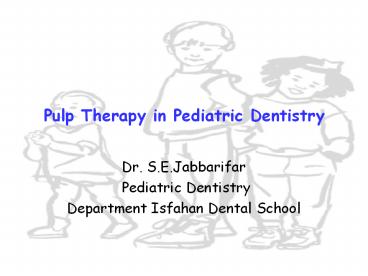Pulp Therapy in Pediatric Dentistry - PowerPoint PPT Presentation
1 / 17
Title:
Pulp Therapy in Pediatric Dentistry
Description:
Pulp Therapy in Pediatric Dentistry ... in Pediatric Dentistry --Vital Pulp Therapy-- Permanent Tooth Pulpotomy Objectives Maintain vitality of radicular ... – PowerPoint PPT presentation
Number of Views:354
Avg rating:3.0/5.0
Title: Pulp Therapy in Pediatric Dentistry
1
Pulp Therapy in Pediatric Dentistry
- Dr. S.E.Jabbarifar
- Pediatric Dentistry
- Department Isfahan Dental School
2
Pulp Therapy in Pediatric Dentistry--Vital Pulp
Therapy--
- Permanent Tooth Pulpotomy
- Objectives
- Maintain vitality of radicular pulp
- Achieve root-end closure (Apexogenesis)
- Eliminate need for apicoectomy
- Facilitate GP obturation with apical stop
3
Pulp Therapy in Pediatric Dentistry--Vital Pulp
Therapy--
- Permanent Tooth Pulpotomy Agents
- Formocresol
4
Pulp Therapy in Pediatric Dentistry--Non-Vital
Pulp Therapy--
- Objectives of Non-Vital Pulp Treatment (Primary
Teeth) - Maintain tooth free of infection
- Achieve biomechanical cleansing and canal
obturation - Promote physiologic resorption
- Maintain space and function
5
Pulp Therapy in Pediatric Dentistry--Non-Vital
Pulp Therapy--
- Non-Vital Pulp Treatment (Primary Teeth)
- Choices
- Pulpectomy (most are partial due to anatomy)
- Extraction
6
Pulp Therapy in Pediatric Dentistry--Non-Vital
Pulp Therapy--
- Pulpectomy Indications/Considerations
- Strategic importance of tooth (2nd primary molar
with unerupted 6-yr molar) - Sufficient remaining tooth structure
- Poor chance of vital pulp treatment success
- Adequate remaining root
- Cooperative patient
7
Pulp Therapy in Pediatric Dentistry--Non-Vital
Pulp Therapy--
- Pulpectomy Contraindications
- A non-restorable tooth
- A tooth with a mechanical or carious perforation
of the floor of the pulp chamber - Pathologic root resorption involving more than
one-third of the root - Pathologic loss of bone support resulting in loss
of the normal periodontal attachment - The presence of a dentigerous or follicular cyst
- Radiographically visible internal root resorption
8
Pulp Therapy in Pediatric Dentistry--Non-Vital
Pulp Therapy--
- Pulpectomy Technique
- Achieve adequate anesthesia and rubber dam
isolation. - Remove all caries.
- Remove the roof of the pulp chamber with a
high-speed handpiece. - Amputate the coronal aspect of the pulp tissue
with a large round bur in a slow-speed handpiece. - The remaining pulp tissue occupying the root
canals is removed using endodontic files at a
predetermined working length, approximately 1 to
2 mm short of the root apices. - The canals should be enlarged several sizes
beyond the size of the first file that fits
snugly into the canal to a minimum final size of
30 to 35. - Throughout root canal instrumentation, the canals
should be irrigated with sodium hypochlorite to
aid in debridement.
9
Pulp Therapy in Pediatric Dentistry--Non-Vital
Pulp Therapy--
- Pulpectomy Technique (continued)
- 8. Dry the canals with sterile paper points.
- 9. The canals are filled with a treatment paste
(Zinc Oxide/Eugenol at UKCD) using a pressure
syringe. - 10. The tooth is restored with a stainless steel
crown.
10
Pulp Therapy in Pediatric Dentistry--Non-Vital
Pulp Therapy--
11
Pulp Therapy in Pediatric Dentistry--Non-Vital
Pulp Therapy--
- Criteria for an ideal pulpectomy obturant
(treatment paste) - Antiseptic
- Resorbable
- Harmless to the adjacent tooth germ
- Radiopaque
- Non-impinging on erupting permanent tooth
- Easily inserted
- Easily removed
12
Pulp Therapy in Pediatric Dentistry--Non-Vital
Pulp Therapy--
- Apexification (Young Permanent Teeth)
- Apical closure of an incompletely formed root
- Implemented when apexogenesis has failed
- Necrotic tissue removal short of the
apexification site - Agent is placed in canals to achieve
closure/apical stop - Apexification Recall Schedule
- Calcium Hydroxide Rotation
- 3-6 month intervals (Andreasen, 1994)
13
Pulp Therapy in Pediatric Dentistry--Non-Vital
Pulp Therapy--
- Action of Calcium Hydroxide in Apexification
- Bactericidal
- Low grade irritation inducing hard tissue barrier
formation - Dissolves necrotic debris
- Forms of Calcium Hydroxide
- Caliscept
- Self-mixed (CaOH sterile water or local
anesthetic)
14
Pulp Therapy in Pediatric Dentistry--Non-Vital
Pulp Therapy--
- Evaluation of Success
- Asymptomatic
- Radiographic absence of pathology
- Continued root development
- Hard tissue barrier at apex
- Responsive pulp
15
Pulp Therapy in Pediatric Dentistry--Non-Vital
Pulp Therapy--
- In Review. . .
16
FYI
- Comparison between File Size and Needle for
Pressure Syringe - Standard File Needle Gauge
- 15-30 30
- 40 27
- 50 25
- 70-80 22
- 90-100 18
17
References
- Barr Elizabeth, Flaitz Catherine, Hicks John. A
retrospective radiographic evaluation of primary
molar pulpectomies. Pediatric Dentistry, Vol.
13, Number 1, 1991 4-9. - Dummett, Cliff. Pulp Therapy in Pediatric
Dentistry. Louisiana State University School of
Dentistry, April 16, 2003. - Georig Albert C., Camp Joe H. Root canal
treatment in primary teeth a review.
Pediatric Dentistry, Vol. 5, Number 1, 1983
33-37. - Nash David A. Pulpal Therapy, Module 6. West
Virginia University School of Dentistry. - Mink, John R. and Spedding, Robert. Pediatric
Pulp Treatment. University of Kentucky College
of Dentistry. - Pinkham, J. R., senior editor. Pediatric
Dentistry, Infancy through Adolescence, Third
Edition. W.B. Saunders Company, 1999. - Walton, Richard E. and Torabinejad, Mahmoud.
Principles and Practice of Endodontics, Second
Edition. W.B. Saunders Company, 1996. - The Handbook, Second Edition. American Academy
of Pediatric Dentistry, 1999.

